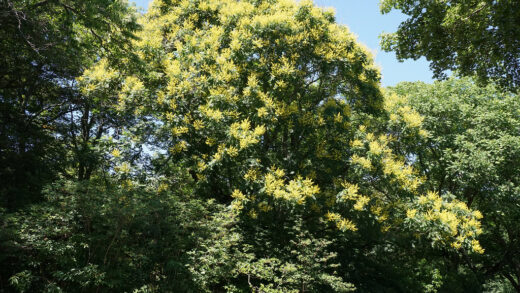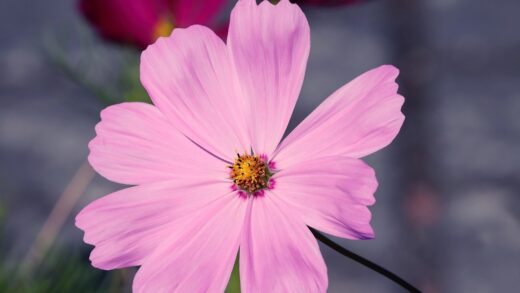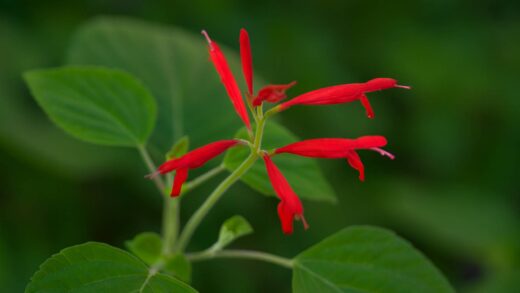The fuchsia, this exceptionally popular and visually diverse ornamental plant, rewards us year after year with a magnificent bloom when properly cared for. One of the key elements of this care is expert pruning and cutting back. Many may perhaps shy away from this task, yet with a little attention and the acquisition of the right techniques, we can not only ensure the plant’s health and vigor but also shape it to our liking and encourage more abundant flowering. Pruning, therefore, is not a type of forceful intervention but a conscious and goal-oriented process that contributes to the long-term preservation of the fuchsia’s beauty and vitality.
The fundamental aim of pruning is to direct the plant’s energy in the right direction. If we neglect to prune our fuchsia, it can become leggy over time, its branches may become sparse, and flowering can also diminish. Expertly performed cutting back, conversely, encourages the formation of new shoots, results in a bushier, more compact shrub form, and promotes the development of a greater number of flower buds. Just consider, with every cut, we stimulate the plant to develop new shoots from dormant buds, shoots that can then produce new flowers.
Pruning is also essential for maintaining the plant’s health. By removing dead, damaged, or diseased branches, we prevent the establishment and spread of pathogens and pests. A well-ventilated plant with a loose branch structure is less exposed to fungal infections, as the leaves dry more quickly and a moist microclimate favorable to pathogens does not form. This is particularly important for fuchsias, which under certain conditions can be susceptible, for example, to grey mould.
Finally, but no less importantly, pruning offers the opportunity to rejuvenate the plant. Older fuchsias may tend to become bare at the base, their branches can lignify, and their desire to flower may wane. With more vigorous pruning, we can stimulate even such specimens to new growth, almost breathing new life into them. This type of intervention ensures that our beloved fuchsia can remain an ornament in our garden or on our balcony for many years, renewing itself year after year and delighting us with its flowers.
Why fuchsia pruning is necessary
One of the main reasons for pruning fuchsias is to maintain the plant’s vegetative and generative balance, that is, to achieve the desired shape and flowering intensity. Pruning encourages the formation of side shoots, which results in a denser, bushier plant. According to the principle of apical dominance, the terminal buds inhibit the development of the side buds below them; by pruning, we break this dominance, allowing for the development of a denser branch system. The more healthy shoots a plant has, the more places it can flower, so the floral display will also be richer. Pruning is therefore a kind of communication with the plant, through which we influence its growth habit and energy distribution.
More articles on this topic
From the point of view of maintaining plant health, the role of pruning is also exceptional. The removal of dried, diseased, or damaged plant parts is a fundamental phytosanitary measure. These parts, indeed, can serve as a nutrient medium for various pathogens, such as fungi or bacteria, and also attract pests. By pruning, we also improve the aeration of the foliage, reducing humidity inside the plant, which also contributes to the prevention of fungal diseases. An expertly pruned fuchsia will be more resistant to environmental stress and diseases.
In the case of older, perhaps already somewhat neglected fuchsias, pruning also functions as a kind of rejuvenation treatment. The removal of lignified, less productive branches, or even more vigorous pruning, encourages the plant to develop new, strong shoots from the basal parts. In this way, the plant is renewed, regains its vitality, and will be capable of more abundant flowering in the following season. Therefore, let us not be afraid to occasionally prune older plants more boldly, as this ensures the long-term beauty and vitality of our fuchsia.
Finally, pruning is also important from an aesthetic point of view. It offers the possibility to adapt the shape of the fuchsia to our personal taste or the available space. Whether it is a compact shrub form, an elegantly trailing hanging plant, or even a fuchsia standard, regular and thoughtful pruning is indispensable for achieving and maintaining the desired shape. A beautifully shaped plant not only produces more flowers but is also, in itself, an ornament in our garden, harmoniously integrating into its surroundings.
Tools and preparations for pruning
No complex or expensive set of tools is needed for pruning fuchsias, however, tools of appropriate quality and in good condition are indispensable for successful work. The most important tool is a sharp pair of pruning shears. Ideally, one should choose so-called bypass pruning shears, whose blades slide past each other like scissors, thus ensuring a clean, uncrushed cutting surface. Avoid anvil-type pruners for fuchsias, as they tend to crush and damage the soft stems. A sharp blade is crucial because blunt tools tear the plant tissues, which hinders wound healing and can open the way for pathogens.
More articles on this topic
Before starting pruning, and even during it if pruning multiple plants or a part that looks diseased, disinfection of the tools is essential. This prevents the transmission of diseases from one plant to another, or even from an infected branch to healthy parts of the same plant. For disinfection, one can use, for example, rubbing alcohol (at least 70%), denatured alcohol, or even a hypochlorite-based disinfectant (e.g., household bleach diluted in water at a 1:9 ratio), but in the latter case, care must be taken to rinse and dry the metal tools afterwards to avoid corrosion. Disinfection is a simple but extremely important step in plant protection.
Although the fuchsia does not belong to particularly dangerous plants, it is worth following some basic precautions during pruning. The use of gloves is recommended to protect hands from possible scratches and from the plant sap, which in some people can cause skin irritation. If pruning a dense, overgrown plant where there is a risk of branches hitting the eyes, wearing safety glasses is not an exaggeration. Comfortable work clothing that does not restrict movement and ensures that one can fully concentrate on the task is also important.
Before we start pruning, let’s dedicate a few minutes to a thorough inspection of the plant. Let’s observe its general condition, the arrangement of the branches, and look for any dead, diseased, or damaged parts. Let’s plan mentally what we want to achieve with the pruning: to shape, rejuvenate, or just encourage flowering. Let’s prepare a container or bag to collect the cut plant parts, so that our workspace remains clean and tidy. Good preparation is half the success and helps to make pruning efficient and smooth.
Spring pruning of fuchsias
The timing of spring pruning is crucial for the healthy development and abundant flowering of the fuchsia. Generally, it can be said that the most ideal time is when the danger of more severe frosts has passed and the plant begins to show signs of life, producing new shoots. In many temperate climates, this usually means the period from late March to mid-April, but one should always consider the current weather conditions. Pruning too early can lead to damage to fresh shoots from a late frost, while pruning too late can delay the onset of flowering. The goal is for the plant, after pruning, to have enough energy and time to develop new, flowering shoots.
The main purpose of spring pruning is to shape the plant, encourage branching, and remove dead or weak stems. As a first step, carefully examine the plant and remove all dried, frozen, or diseased-looking branches back to the healthy part. Subsequently, shorten the remaining healthy shoots. As a general rule, the previous year’s growth should be shortened by about one-third to one-half, always making the cut just above an outward-facing pair of buds. This stimulates branching and prevents the center of the plant from becoming too dense.
Different fuchsia varieties and forms may have different pruning needs. For bushy, upright-growing varieties, aim to create a balanced, rounded, or slightly spreading crown. For trailing varieties, intended for hanging baskets, pruning can enhance the dense, cascading effect, while also ensuring that the plant does not become bare at the base. If growing a fuchsia standard, spring pruning should shape the crown to the desired size and density, while regularly removing any side shoots that may appear on the stem.
After spring pruning, the fuchsia requires increased attention to regain strength and begin growth. Provide it with a bright location, but protected from direct sun. After pruning, once new shoots have appeared, regular fertilization can begin with a balanced, bloom-boosting liquid fertilizer. Adjust watering to the plant’s needs and environmental conditions, ensuring that the soil is always slightly moist but not waterlogged. Careful aftercare will be rewarded, and your fuchsia will soon begin flowering with renewed vigor.
Summer pinching and maintenance pruning of fuchsias
Summer pinching, or nipping out, primarily serves to maintain continuous and abundant flowering of the fuchsia and to preserve the plant’s shape. The essence of pinching is to remove the tips of young, not yet lignified shoots, usually above the last one or two pairs of leaves. This intervention encourages the plant to develop new shoots from hitherto dormant side buds, which then produce additional flowers. Pinching can be performed multiple times during the growing season, especially on young, still-developing plants, to cultivate a dense, well-branched shrub.
Regular removal of spent flowers (deadheading) is also crucial during summer care. If we leave the faded parts of the fuchsia on the plant, it will spend its energy on seed formation instead of developing new flowers. Remove the spent flowers along with their stems, preferably before seed pods begin to appear. This not only prolongs the flowering period but also makes the plant aesthetically more attractive, preventing a messy, neglected appearance.
During the summer, minor corrective pruning may also be necessary. We can remove shoots that deviate from the desired shape, have perhaps become too elongated, or are growing towards the interior of the plant, densifying the foliage. Also pay attention to any damaged, broken branches or those showing signs of disease, and remove them immediately to prevent the spread of problems. During summer heat and high humidity, it is particularly important to ensure good air circulation inside the plant to avoid fungal infections.
The extent and frequency of summer pinching can also be adjusted according to when one wishes to achieve the most intense flowering. If, for example, we want our fuchsia to show its best form for a specific event, then pinching should be timed accordingly, taking into account that the plant usually needs a few weeks after pinching to produce new flowers. Continuous, but less extensive pinching results in a more uniform, long-lasting bloom, while after a more vigorous, one-time pinching, we can expect a more concentrated, but perhaps later wave of flowering.
Autumn pruning and preparation for overwintering
The main purpose of autumn pruning is to prepare the fuchsia for the winter dormancy period, especially for varieties that are not frost-hardy and require overwintering. This pruning helps to reduce the size of the plant, making it easier to place in its overwintering location, and removes weak, diseased, or damaged parts that could cause problems during the winter months. It is important not to carry out autumn pruning too early, while the plant is still actively growing, but also not to wait until the first more severe frosts. The ideal time is usually around October, when the days are getting shorter and temperatures are also declining.
The extent of autumn pruning is generally more moderate than that of the main spring pruning. It is recommended to shorten the shoots by about one-third or half, removing remaining flowers, buds, and soft, fresh shoot tips that would likely freeze or rot during the winter. Avoid drastic pruning immediately before overwintering, as the plant can become more susceptible to cold and diseases through the cut wounds. The goal is to create a compact, yet still viable plant form that will successfully survive the winter.
In addition to pruning, preparation for overwintering also includes other important steps. Gradually reduce watering so that the soil remains only slightly moist, and stop fertilizing completely so that the plant can enter a dormant state. Before taking the fuchsia to its overwintering location, inspect it thoroughly for pests and diseases. If necessary, carry out a plant protection treatment to prevent the introduction and spread of problems in the enclosed space. Clean, healthy plants have a greater chance of surviving the winter.
The overwintering of different fuchsia types can vary. Fully frost-hardy varieties, such as Fuchsia magellanica and some of its hybrids, can also be overwintered in the garden with appropriate protection (e.g., leaves, mulch); for these, autumn pruning is mainly limited to removing damaged parts and a slight adjustment of the plant’s shape. However, most of the popular cultivated fuchsias are frost-sensitive and therefore must be overwintered in a bright, cool (5-10 °C or 41-50 °F), frost-free place, for example in a cellar, garage, or unheated room. In their case, the more thorough autumn pruning and preparation described in detail earlier are crucial.
Special pruning techniques and troubleshooting
The versatility of fuchsias is manifested in the fact that they can be grown not only as shrubs or trailing plants but can also be shaped into more special forms, such as standards (small trees on a single stem). Creating such a form requires patience and consistent pruning. The process begins with the selection of a strong, straight central shoot, which is grown with the support of a stake. The lower side shoots are regularly removed until the stem reaches the desired height. After that, its tip is pinched to encourage branching and form the crown, which is then shaped and densified with spring and summer pruning.
In the case of old, neglected, possibly bare or lignified fuchsias, more vigorous rejuvenation pruning can offer a new chance. This means that the plant, in spring, after the end of frosts, is pruned relatively hard, even to a few buds above ground level. Although this may seem like a drastic intervention, many fuchsias react well to it and develop new, strong shoots from dormant buds. It is important, in this case, to pay particular attention to appropriate aftercare: water carefully after cutting and resume fertilizing only when the new shoots have developed well. This method can be riskier, but often it can save a plant that would otherwise have been written off.
During pruning, mistakes can occur that are worth avoiding to preserve the plant’s health. A common mistake is pruning too little or, conversely, too much. If not pruned enough, the plant becomes leggy and flowers sparsely; if cut back too much, especially at the wrong time, it can weaken it. Avoid using blunt, dirty tools, as these damage the tissues and can cause infections. It is also important to make the cut correctly: always cut slightly above a bud or pair of leaves, slightly angled, so that water can drain, and do not leave stubs that are too long, as these can die back and become a source of disease.
If, after pruning, the plant shows signs of stress, for example, the leaves turn yellow, wilt, or if alterations appear near the cut surfaces indicating an infection, one must act quickly. Check the watering, ensure adequate light conditions and good air circulation. If a fungal infection is suspected, remove the diseased parts and, if necessary, apply an appropriate fungicide. Remember, pruning causes a kind of wound to the plant, therefore careful aftercare and ensuring favorable environmental conditions are essential for rapid regeneration and healthy continued development.




















